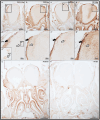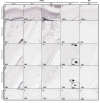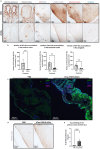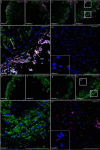The olfactory epithelium: a critical gateway for pathological tau propagation and a target for mitigating tauopathy in the central nervous system
- PMID: 40536690
- PMCID: PMC12179005
- DOI: 10.1007/s00401-025-02902-6
The olfactory epithelium: a critical gateway for pathological tau propagation and a target for mitigating tauopathy in the central nervous system
Abstract
Olfactory impairment is a recognized early indicator of neurodegenerative diseases (NDs), such as Alzheimer's disease (AD). Intracellular aggregates of hyperphosphorylated tau protein, referred to as neurofibrillary tangles (NFTs), are a hallmark of AD. NFTs are found in the olfactory bulb (OB) and entorhinal cortex (EC), both crucial for processing olfactory information. We explored the hypothesis that typical tau lesions could appear early and progress along olfactory regions to reach connected areas critically affected in AD (e.g., EC and hippocampal formation). To that end, we used transgenic PS19 mice expressing mutated human tau protein (1N4R isoform, P301S mutation). They recapitulate major phenotypes of AD, such as accumulation of NFTs, synaptic dysfunction, cognitive impairment, and neuronal loss. The presence of pathological hyperphosphorylated human tau protein (pTau) was monitored in olfactory regions: olfactory epithelium (OE), OB, piriform cortex (PC), and in connected regions of the hippocampal formation (hippocampus and EC). pTau was detected in the OE's middle stratum and in the OB's olfactory nerve layer (ONL) at 1.5 months. At 6 months of age, tau accumulations were found in the PC and EC, along with the CA3 region and dentate gyrus of the hippocampus. We found that olfactory function remained unaffected in PS19 mice, despite the presence of tau pathology in key regions of the olfactory system. Targeted treatments (ZnSO4 and AAVs) were applied at the OE level to assess the impact on tau pathology in the CNS. Complete stripping of the OE by intranasal administration of ZnSO4 led to a significant reduction in pretangle-like tau pathology within the PC, amygdala, and EC of 6-month-old PS19 mice. Finally, we observed in human postmortem samples that pTau signal was present in the olfactory regions (OE and OB) of patients at early Braak stages (I/II). Based on these observations, we propose that pTau could appear, due to aging or environmental agents, in the OE and subsequently spread in a prion-like manner to the hippocampal formation along neuroanatomical connections. These findings also indicate the interest of the OE as a target for intervention aimed at mitigating the progression of tauopathy in the CNS.
Keywords: Olfaction; Olfactory system; Tau pathology; Tau spreading.
© 2025. The Author(s).
Conflict of interest statement
Declarations. Conflicts of interest: DRT and SOT received consultant honoraria from Muna Therapeutics. DRT collaborated with Novartis Pharma AG (Switzerland), and GE Healthcare (UK). The other authors have no competing interests to declare that are relevant to the content of this article. Ethical approval: All animal procedures were conducted in accordance with institutional and European guidelines and approved by the UCLouvain Ethical Committee for Animal Welfare (2021/UCL/MD/018). Human postmortem brain tissue was collected in accordance with the applicable legislation in Belgium. The recruitment protocols for the collection of human brains were approved by the ethical committee (2020/02JUL/355).
Figures











References
-
- Ahnaou A, Rodriguez-Manrique D, Biermans R, Embrechts S, Manyakov NV, Drinkenburg WH (2020) Functional alterations in the olfactory neuronal circuit occur before hippocampal plasticity deficits in the P301S mouse model of tauopathy: implications for early diagnosis and translational research in Alzheimer’s disease. Int J Mol Sci. 10.3390/ijms21155431 - PMC - PubMed
-
- Aragão Gomes L, Uytterhoeven V, Lopez-Sanmartin D, Tomé SO, Tousseyn T, Vandenberghe R et al (2021) Maturation of neuronal AD-tau pathology involves site-specific phosphorylation of cytoplasmic and synaptic tau preceding conformational change and fibril formation. Acta Neuropathol 141(2):173–192. 10.1007/s00401-020-02251-6 - PubMed
-
- Arnold SE, Smutzer GS, Trojanowski JQ, Moberg PJ (1998) Cellular and molecular neuropathology of the olfactory epithelium and central olfactory pathways in Alzheimer’s disease and schizophrenia. Ann N Y Acad Sci 855:762–775. 10.1111/j.1749-6632.1998.tb10656.x - PubMed
Publication types
MeSH terms
Substances
Grants and funding
LinkOut - more resources
Full Text Sources
Medical
Miscellaneous

